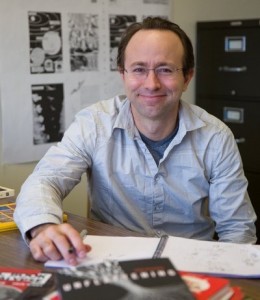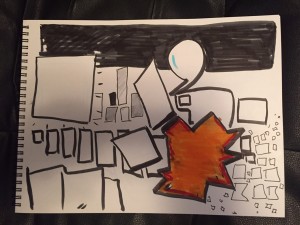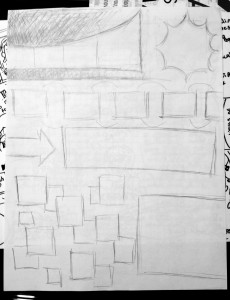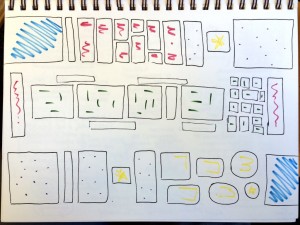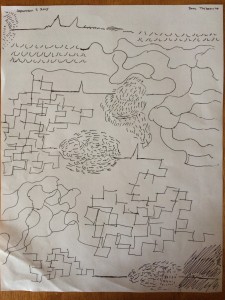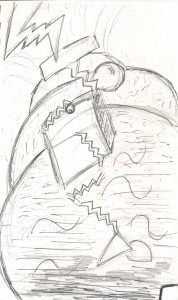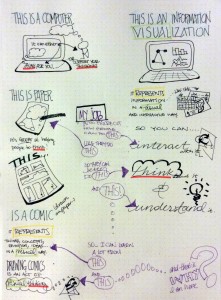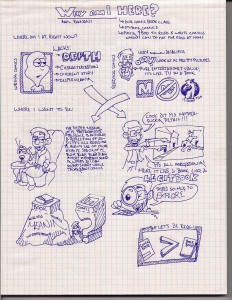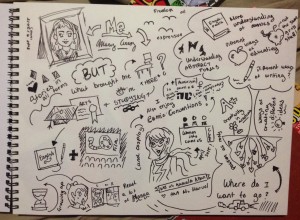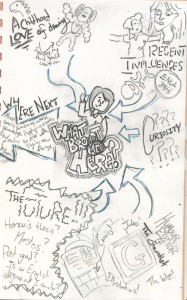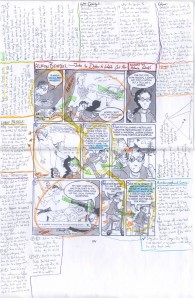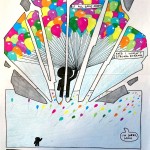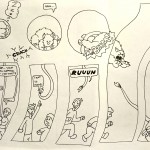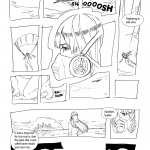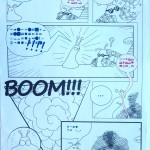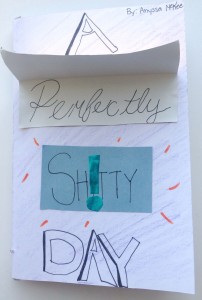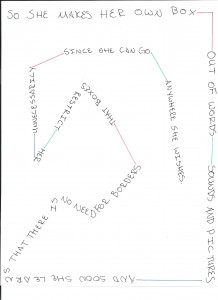This time out, I share some work from my comics as a way of thinking course, which just wrapped. But first, some news on Unflattening.
The October issue of the American Library Association’s “Choice: Reviews” kindly called Unflattening “potentially revolutionary.” The full text reads:
“For more than two decades, Scott McCloud’s Understanding Comics: The Invisible Art (1993) has been the cornerstone of nearly every syllabus for courses on comic books and graphic novels. Though nothing can usurp it, Sousanis’s Unflattening now provides the answer to the question, “What next?” Unflattening will no doubt become an essential teaching tool for helping students—especially undergraduates—think about comics, graphic novels, and other media in which words and images combine. With a goal of “providing an elevated perspective from which to illuminate the traps of our own making and offer a means to … step out,” Sousanis (comics studies, Univ. of Calgary, Canada) wishes to “unflatten” readers, allowing them to resee, unsee, or see differently. The book was originally Sousanis’s PhD dissertation, and as a new way of conducting academic discourse—one that weaves a rich tapestry of theory and intertextuality beyond the cage of language and the limited pedantic form of the “essay”—the book is potentially revolutionary. Rather than obfuscation and hoarding of knowledge, there is a generous opening outward into ever-deepening complexity. This is a book that wants to teach, a book that will be talked about and belongs in any forward-looking library. –R. J. Baumann, Lilly Library, Indiana University. Summing Up: Essential. All readers.” (Partially online here)
Unflattening made the venerable Kenyon Review’s list of recommended readings alongside Ta-Nehisi Coates and many others! They describe it as:
“the most compelling doctoral dissertation you’ll ever read. This graphic novel, which began as Nick Sousanis’ doctoral dissertation at Columbia University, explores how knowledge is made, specifically in the intersection of image and utterance in the making of meaning. A modern day mashup of philosophy and critical theory, there is poetry at work in this contemplative comic book that offers as fresh a take on the genre as Spiegelman’s Maus did when it first hit the bookracks in 1991.”
Pleased to be included – see the entire review and the other titles mentioned on the Kenyon Review’s site here.
The University of Calgary’s Today ran a profile on me and my comic on climate change that was recently published in Nature in conjunction with COP21. Read Heath McCoy’s interview with me here. A complete list of reviews and interviews can be found here.
This term I’ve been teaching a new iteration of my comics courses – “Comics as a Way of Thinking.” This was a theory and readings course built around an emphasis on making comics – and everyone working visually from day one, regardless of prior drawing experience. My aim with this approach is two-fold – to give students a better understanding of how comics do through hands on play and to reawaken the possibilities of working visually, something they can bring to whatever work they do. The class was, to say the least, a blast – and I’m so pleased by what these students discussed and produced over the past three months. They’ve granted me permission to share excerpts of their work, so I’ll start that here with a likely follow up in early January (in conjunction with a panel I’m doing on teaching comics at MLA).
One of the first things we do is an exercise I made up for the class that I also frequently do in public talks that I call Grids & Gestures. I mentioned it in some detail here, and I wrote it up in detail for publication this fall in the SANE comics education journal here. In short, this exercise asks participants to organize the events of their day into a compositional shape on a single sheet of paper thinking about the way comics organize time in space. (For full explanation, do see the published writeup.) I like starting here because it gets people thinking about the entire page from the ground up, and because I stress that they are not to draw representational things – it allows them to draw without falling back on stick figures. Ultimately, it ends up prompting discussion about how much about drawing they already know and how in working visually they start to notice things about their thinking they wouldn’t when working otherwise. For me, it sets a good tone for the class to really question what drawing can be and how much comics can do through organization of the form alone.
From there (and I’ve got the whole class syllabus posted here), we try a whole variety of exercise – some quick in-class and others to work on at home, that are aimed to parallel what we’re discussing in terms of theory. I’ve found that in the act of making, students always hit upon sophisticated concepts that we later come across in the comics we study. This time around, I had them do sketch-notes for the “how you got here/what do you want to take from this experience” exercise at the beginning of the course. I shared a few links with them to give them an idea of what a sketch note is (again on the syllabus), and they ran with it. Matt Madden and Jessica Abel’s brilliant collaborative comics-making Panel Lottery gets students working together, as it simultaneously gets them thinking about how story is constructed – even from nearly random elements.
One of my favorite things, is not quite making comics – it’s visually analyzing/annotating a comics page by writing/drawing/diagramming directly on the work. It invites one to start noticing everything the comics maker employs to construct meaning on the page – and they often result in this beautiful and insightful explosion of thinking. We did it a few times, and when we read Ellen Forney’s Marbles, I had them do a sketch note about the book with a mini-analysis embedded within. See some samples of these visual annotations in a pdf here.
One thing that turned out far better than expected, started with each student taking a sheet of paper and in five minutes constructing a panel layout. When they were done, we passed to another student – who in the first iteration of this exercise took it home and drew it, and then brought it back and passed again for the final student to add words. This worked well, but then we did it again where we started the same, but as the second step had the person add words, and then in the final step they drew pictures. They really enjoyed the challenge of this, and the comic with balloons shown first above – was not only impressive for the exercise, I found it to be one of the strongest single page comics I’ve seen! There was something almost magic in how the disparate elements came together. A lot of fun all in all and taught us a lot about creative process.
Finally, for this time around, I want to share a few of their final projects. The assignment was to do something in comics or comics-like that tackled something related to the class and their own work. Projects ranged from an augmented reality comics-making thing (which i can’t share at this point) to personal explorations of loss. I’m putting just a handful of them here, but I’ll revisit again and share more and some of the other exercises we did.


